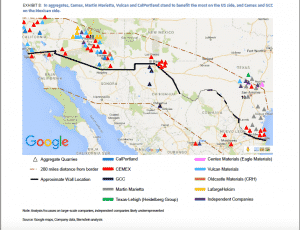Trump’s grotesque and shameful border “Wall”, will be a massive engineering project. Median estimate of the cost seems to be around $ 15 bn. Another $ 500 bn may go on infrastructure. It will consume huge quantities of cement. In excess of 7 million tons is the most common estimate. As he walls America in and Mexico out, the Mexican currency plunges. But some Mexican stocks are doing well. Why? Well, ask the question: who makes the cement and aggregate that will go into The Wall?
Globally roughly 4 bn tons of the basic building glue – cement – were produced in 2015. It is a major driver of the anthropocene, accounting, according to source, for between 5 % and 10 % of carbon emissions. http://www.economist.com/news/business/21705861-why-grey-firms-will-have-go-green-cracks-surface In economic terms, cement, concrete and aggregate industry are a $ trillion dollar business. Cement alone generates about $ 250 bn annually in revenues. China’s massive growth means that it accounts for roughly half of all global production of cement, with demand being serviced by several giant Chinawide firms and a mass of smaller producers. India is the second largest market with a cluster of national producers. The rest of the world, including North America, is supplied by a cluster of massive multinational, high-tech cement firms. The two biggest LafargeHolcim and HeidelbergCement are European. After them, comes CEMEX, which is … Mexican.


Because the stuff is so heavy it is uneconomic to move it any more than 200 miles, if that. So the big companies do not ship concrete globally. They own and coordinate sprawling networks of hundreds of production facilities around the world. And Mexico’s CEMEX is particularly notable for its high tech distribution network with roving GPS-controlled cement mixer vehicles touring high-demand areas to be available on call – a bit like a cement-delivery drone. And they did this back in the early 2000s. Indeed, CEMEX is the subject of a MIT Business School study on globalization, which shows that its powerful push to globalize was driven in large part by an earlier bout of American economic nationalism. In 1989 the US slapped countervailing duties on Mexican cement imports. CEMEX responded by buying its way into other Latin American and European markets and ultimately by purchasing rival US suppliers.


Engineering consultants Bernstein have produced fascinating maps of the distribution of aggregate and cement supply facilities in the US-Mexico border region and there is simply no alternative but to buy the raw materials from Mexican producers, who in any case operate facilities as much in the US as in Mexico and employ 1000s of American workers.
Takeaways: (1) Cement is fascinating – drone-like mixers, who would have thunk it. (2) The world of multinational capitalism is multipolar. (3) Even a perverse and humiliating act of separation ends up reinscribing and reproducing the US-Mexican entanglement. (4) thinking, digging, investigating, writing all help against the sense of shame and disgust one must feel in dealing with this subject mattered. In fact there is an entire field out there to be explored: the economics of border fortifications ….

